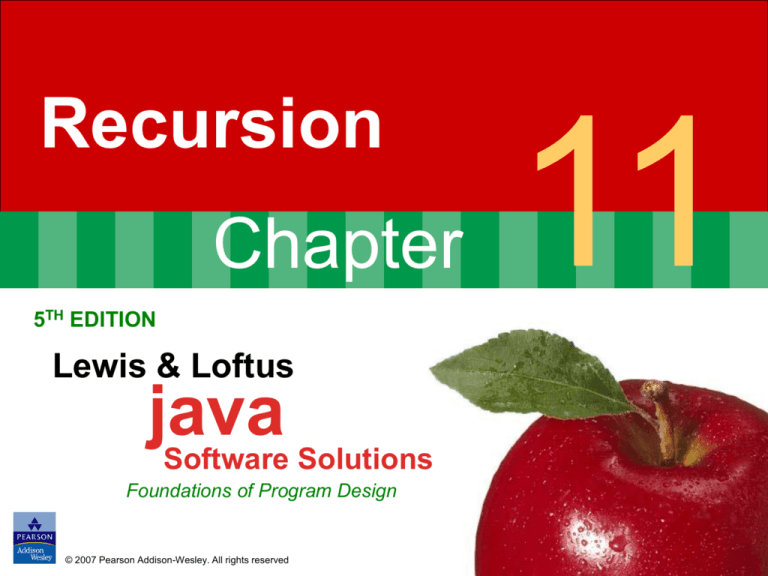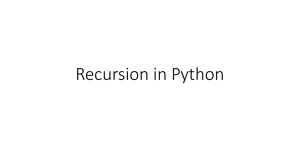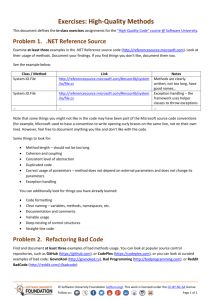
Recursion
Chapter
5TH EDITION
Lewis & Loftus
java
Software Solutions
Foundations of Program Design
© 2007 Pearson Addison-Wesley. All rights reserved
11
Recursion
• Recursion is a fundamental programming
technique that can provide an elegant solution
certain kinds of problems
• Chapter 11 focuses on:
thinking in a recursive manner
programming in a recursive manner
the correct use of recursion
recursion examples
© 2007 Pearson Addison-Wesley. All rights reserved
11-2
Outline
Recursive Thinking
Recursive Programming
Using Recursion
Recursion in Graphics
© 2007 Pearson Addison-Wesley. All rights reserved
11-3
Recursive Thinking
• A recursive definition is one which uses the word
or concept being defined in the definition itself
• When defining an English word, a recursive
definition is often not helpful
• But in other situations, a recursive definition can
be an appropriate way to express a concept
• Before applying recursion to programming, it is
best to practice thinking recursively
© 2007 Pearson Addison-Wesley. All rights reserved
11-4
Recursive Definitions
• Consider the following list of numbers:
24, 88, 40, 37
• Such a list can be defined as follows:
A LIST is a:
or a:
number
number
comma
LIST
• That is, a LIST is defined to be a single number, or
a number followed by a comma followed by a LIST
• The concept of a LIST is used to define itself
© 2007 Pearson Addison-Wesley. All rights reserved
11-5
Recursive Definitions
• The recursive part of the LIST definition is
used several times, terminating with the
non-recursive part:
number comma LIST
24
,
88, 40, 37
number comma LIST
88
,
40, 37
number comma LIST
40
,
37
number
37
© 2007 Pearson Addison-Wesley. All rights reserved
11-6
Infinite Recursion
• All recursive definitions have to have a nonrecursive part
• If they didn't, there would be no way to terminate
the recursive path
• Such a definition would cause infinite recursion
• This problem is similar to an infinite loop, but the
non-terminating "loop" is part of the definition
itself
• The non-recursive part is often called the base
case
© 2007 Pearson Addison-Wesley. All rights reserved
11-7
Recursive Definitions
• N!, for any positive integer N, is defined to be the
product of all integers between 1 and N inclusive
• This definition can be expressed recursively as:
1!
N!
=
=
1
N * (N-1)!
• A factorial is defined in terms of another factorial
• Eventually, the base case of 1! is reached
© 2007 Pearson Addison-Wesley. All rights reserved
11-8
Recursive Definitions
120
5!
24
5 * 4!
6
4 * 3!
3 * 2!
2
2 * 1!
1
© 2007 Pearson Addison-Wesley. All rights reserved
11-9
Outline
Recursive Thinking
Recursive Programming
Using Recursion
Recursion in Graphics
© 2007 Pearson Addison-Wesley. All rights reserved
11-10
Recursive Programming
• A method in Java can invoke itself; if set up that
way, it is called a recursive method
• The code of a recursive method must be
structured to handle both the base case and the
recursive case
• Each call to the method sets up a new execution
environment, with new parameters and local
variables
• As with any method call, when the method
completes, control returns to the method that
invoked it (which may be an earlier invocation of
itself)
© 2007 Pearson Addison-Wesley. All rights reserved
11-11
Recursive Programming
• Consider the problem of computing the sum of all
the numbers between 1 and any positive integer N
• This problem can be recursively defined as:
N
i
N
i 1
N 1
i
N N 1
i 1
N N 1 N 2
N 3
N 2
i
i 1
i
i 1
© 2007 Pearson Addison-Wesley. All rights reserved
11-12
Recursive Programming
// This method returns the sum of 1 to num
public int sum (int num)
{
int result;
if (num == 1)
result = 1;
else
result = num + sum (n-1);
return result;
}
© 2007 Pearson Addison-Wesley. All rights reserved
11-13
Recursive Programming
result = 6
main
sum(3)
sum
result = 3
sum(2)
sum
result = 1
sum(1)
sum
© 2007 Pearson Addison-Wesley. All rights reserved
11-14
Recursive Programming
• Note that just because we can use recursion to
solve a problem, doesn't mean we should
• For instance, we usually would not use recursion
to solve the sum of 1 to N problem, because the
iterative version is easier to understand
• However, for some problems, recursion provides
an elegant solution, often cleaner than an iterative
version
• You must carefully decide whether recursion is the
correct technique for any problem
© 2007 Pearson Addison-Wesley. All rights reserved
11-15
Indirect Recursion
• A method invoking itself is considered to be direct
recursion
• A method could invoke another method, which
invokes another, etc., until eventually the original
method is invoked again
• For example, method m1 could invoke m2, which
invokes m3, which in turn invokes m1 again
• This is called indirect recursion, and requires all
the same care as direct recursion
• It is often more difficult to trace and debug
© 2007 Pearson Addison-Wesley. All rights reserved
11-16
Indirect Recursion
m1
m2
m3
m1
m2
m1
© 2007 Pearson Addison-Wesley. All rights reserved
m3
m2
m3
11-17
Outline
Recursive Thinking
Recursive Programming
Using Recursion
Recursion in Graphics
© 2007 Pearson Addison-Wesley. All rights reserved
11-18
Maze Traversal
• We can use recursion to find a path through a
maze
• From each location, we can search in each
direction
• Recursion keeps track of the path through the
maze
• The base case is an invalid move or reaching the
final destination
• See MazeSearch.java (page 587)
• See Maze.java (page 588)
© 2007 Pearson Addison-Wesley. All rights reserved
11-19
Towers of Hanoi
• The Towers of Hanoi is a puzzle made up of three
vertical pegs and several disks that slide on the
pegs
• The disks are of varying size, initially placed on
one peg with the largest disk on the bottom with
increasingly smaller ones on top
• The goal is to move all of the disks from one peg
to another under the following rules:
We can move only one disk at a time
We cannot move a larger disk on top of a smaller one
© 2007 Pearson Addison-Wesley. All rights reserved
11-20
Towers of Hanoi
Original Configuration
Move 1
Move 2
Move 3
© 2007 Pearson Addison-Wesley. All rights reserved
11-21
Towers of Hanoi
Move 4
Move 5
Move 6
Move 7 (done)
© 2007 Pearson Addison-Wesley. All rights reserved
11-22
Towers of Hanoi
• An iterative solution to the Towers of Hanoi is
quite complex
• A recursive solution is much shorter and more
elegant
• See SolveTowers.java (page 594)
• See TowersOfHanoi.java (page 595)
© 2007 Pearson Addison-Wesley. All rights reserved
11-23
Outline
Recursive Thinking
Recursive Programming
Using Recursion
Recursion in Graphics
© 2007 Pearson Addison-Wesley. All rights reserved
11-24
Tiled Pictures
• Consider the task of repeatedly displaying a set of
images in a mosaic
Three quadrants contain individual images
Upper-left quadrant repeats pattern
• The base case is reached when the area for the
images shrinks to a certain size
• See TiledPictures.java (page 598)
© 2007 Pearson Addison-Wesley. All rights reserved
11-25
Tiled Pictures
© 2007 Pearson Addison-Wesley. All rights reserved
11-26
Fractals
• A fractal is a geometric shape made up of the
same pattern repeated in different sizes and
orientations
• The Koch Snowflake is a particular fractal that
begins with an equilateral triangle
• To get a higher order of the fractal, the sides of the
triangle are replaced with angled line segments
• See KochSnowflake.java (page 601)
• See KochPanel.java (page 604)
© 2007 Pearson Addison-Wesley. All rights reserved
11-27
Koch Snowflakes
< x5 , y5 >
< x 5 , y5 >
< x 4 , y4 >
Becomes
< x3 , y 3 >
< x 2 , y2 >
< x1 , y1 >
© 2007 Pearson Addison-Wesley. All rights reserved
< x 1 , y1 >
11-28
Koch Snowflakes
© 2007 Pearson Addison-Wesley. All rights reserved
11-29
Koch Snowflakes
© 2007 Pearson Addison-Wesley. All rights reserved
11-30
Summary
• Chapter 11 has focused on:
thinking in a recursive manner
programming in a recursive manner
the correct use of recursion
recursion examples
© 2007 Pearson Addison-Wesley. All rights reserved
11-31








